Figure 1: A portable generator
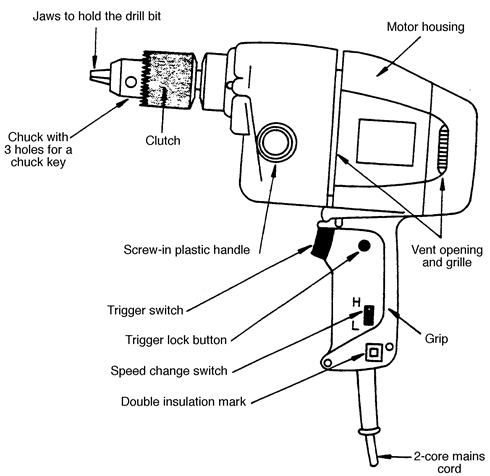
Figure 2: Example of a portable electric drill
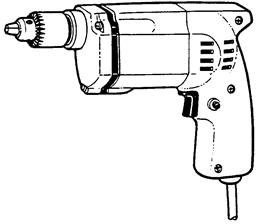
Figure 3: A light-duty portable drill
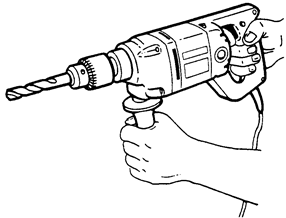
Figure 4: A heavy drill
Electric drills may have additional features, including variable speed, or selectable speed, and hammer action.
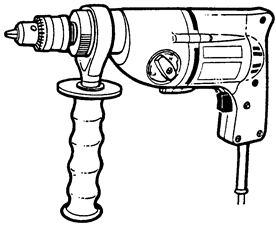
Figure 5: A hammer drill
|
Caution |
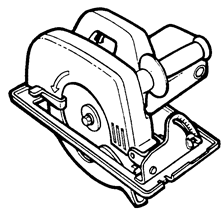
Figure 6: A circular saw
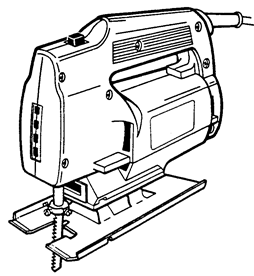
Figure 7: A jig saw
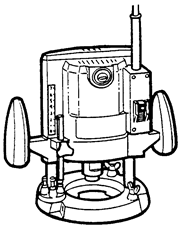
Figure 8: A router
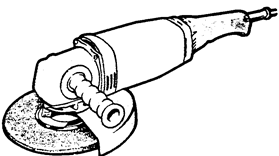
Figure 9: An angle grinder
 |
Student exercise 1 |
1 When using portable power tools you should
(a) Ensure safety guards are securely in _____________.
(b) Keep _____________ away from cutting area.
(c) Keep work area _____________
(d) Avoid damp or _____________________ environments.
(e) Discourage children and _____________________.
(f) When not in use,_____________ tools properly.
(g) Do not apply excessive _____________.
(h) Use the _____________ tool for the job.
(i) Wear _____________ clothing.
(j) Use _____________ glasses.
(k) Do not _____________a flexible cord.
(l) Secure the _____________ piece.
2 How may stalling of a power drill be minimised?
3 The better power drill to use when working near live conductors is
4 What sort of power drill would you find more efficient drilling through masonry?
5 What types of discs can you use on angle grinders?
6 Before using extension cords you should inspect them for
7 What sort of protection device should you use especially when an extension cord or power drill is used in damp situations?
Check your answers with those given at the end of this section.
Grinding work may be divided into two principal groups: hand grinding and machine grinding. In this section we will only give a broad outline of the elementary work of hand grinding; further detail and other processes will be dealt within the various areas when required.
Off-hand grinding is grinding work using an abrasive wheel, while the work or portable machine is held by hand.
One type of portable grinding machine is illustrated in Figure 10. This machine is electrically operated and is used for processing surfaces in preference to chipping or finishing after chipping. Portable pneumatic grinders are also available and are very useful for cleaning up rough castings and similar work, and in many cases eliminate the laborious process of hand chipping; they can be moved to any portion of the shop or job so long as electricity or compressed air is available.
Care must be exercised not to start the machine with the wheel in contact with anything. Always lift the machine with the left hand at the spindle casing at A and the right hand on the trigger guard B, and when near position requiring grinding, then and then only press the trigger to operate the wheel.
In the interest of safety it is necessary to have a safety guard on the wheel as shown in Figure 10; this prevents certain potentially dangerous operations from being carried out, as well as minimising danger should the wheel fracture.
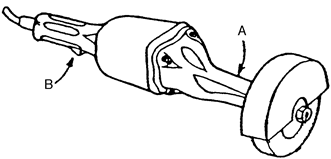
Figure 10: A portable grinder
There are two types of fixed grinder, one having its own pedestal and the other fixed to a bench. Figure 11 illustrates a pedestal type grinder with a wheel at both sides. The wheel guards and rests may be quickly removed. Figure 12 illustrates a bench grinder.
The wheel guards are made with sufficient opening to enable general workshop use. If one of these wheels should break when in operation, serious injury may result to persons even at a distance from the machine unless an adequate guard is provided.
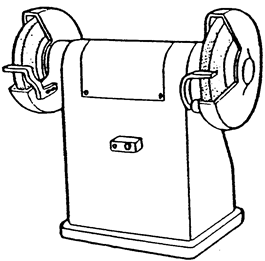
Figure 11: A pedestal grinder
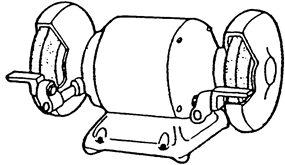
Figure 12: A bench grinder
Grinding wheels have been made from natural and artificial material. The term grindstone refers to a wheel cut from natural stone such as sandstone. The natural abrasives are emery and corundum, and for many years grinding wheels were made with these two natural abrasive materials. These abrasives did not produce the uniformity required for the many grinding processes developed in engineering manufacture.
Artificial grinding wheels are usually referred to as grinding or abrasive wheels. These are composed of:
Artificial abrasives that meet the modern requirements of industry are aluminium oxide, and silicon carbide, the latter being called carborundum when manufactured by the Carborundum Company. There are numerous trade names given to the finished grinding wheels, details of which will not be given here.
When the wheel is used, the abrasive particles will cut or abrade the metal to be ground, and at the same time, the bond is worn or crumbled away to keep the cutting surface of the wheel sharp and effective as shown in Figure 13.
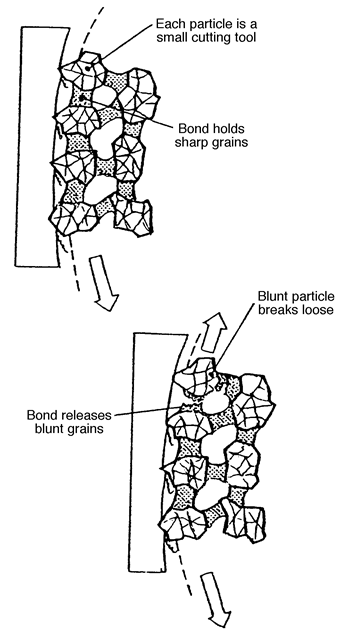
Figure 13: Enlarged view of a simple grinding wheel
Grinding wheels are referred to by their grit size, consequently, a wheel of No. 30 Grit, means that the abrasive particles before being moulded into a wheel would pass through a 30 mesh screen.
The grade of wheel does not refer to the hardness of the material but to the holding ability of the bond. Thus a Soft Grade refers to a wheel whose grit is easily dislodged. One manufacturer uses the following grades: very soft - soft - medium - hard - very hard.
Silicon carbide grit breaks away relatively easily so these wheels cut well and do not readily become dull. They are used for soft materials like brass, aluminium, rubber and plastic materials, also for brittle and hard materials such as rough surfaces of castings, stone, porcelain, and marble.
Silicon carbide wheels are also used for sharpening carbide tipped tools for lathes, planers, etc, but it is desirable not to use the wheel for other purposes.
Aluminium oxide is best suited for grinding materials of high tensile strength, but is used for all steels. If a general purpose wheel is required aluminium oxide should be used.
If a very coarse wheel is being used it will leave a relatively rough surface, consequently it is desirable to have a double wheel machine with a fine wheel on one end, and a coarse wheel on the other end.
 |
Student Exercise 2 |
1 Grinding work may be divided into two groups, they are:
2 What care must be taken with portable grinding machines?
3 What will minimise the danger of a wheel fracture on a portable grinder?
4 Grinding wheels may be divided into two general classes which are:
5 Abrasive wheels consist of:
6 Natural abrasives are:
7 Artificial abrasives are:
8 An artificial grinding wheel that would be used to grind rubber, plastic, rough surfaces of castings and sharpening carbide tipped tools for lathes is:
9 What artificial grinding wheel is most suitable for general purposes?
Check your answers with those given at the end of this section.
To obtain best results, it is important that grinding wheels be run at the speed recommended by the manufacturer. It is dangerous to operate wheels at excessive speeds.
Grinding wheels, especially those of thin section, are very fragile, and even the apparently rugged and larger wheels can be damaged when being mounted.
Figure 14 shows the correct method of mounting wheels. The following rules should be carefully studied and followed:
(a) The wheel should be an easy fit on the spindle but not be slack. A tight fit will cause early fracture, possibly during mounting.
(b) Check the wheel for cracks by tapping gently with a light metal rod.
(Figure 15)
(c) The plates must be recessed at least 1 mm deep to the outer face. This ensures even distribution or pressure and reduces the chances of slipping or breaking of the wheel. If the flanges are made flat the tendency is to bear at the inner face and this will cause early fracture of the wheel.
(d) The flanges should be of equal diameter and at least one- third, but preferably one-half, the wheel diameter, to ensure adequate and equal grip.
Figure 14: Correctly mounted wheel
(e) The inner flange should be firmly attached to the spindle, preferably keyed, and must be running true before the wheel is mounted. The hole in the outer flange should be an easy sliding fit on the spindle.
(f) Blotting paper or rubber washers not greater than 0.5 mm thick must be placed between the wheel and each flange. This soft material ensures even bearing all around against the rough material of the wheel, thus providing a positive drive.
(g) The wheel spindle should be threaded left or right hand so that the wheel tightening nuts will tend to tighten as the spindle revolves.
Figure 15: Testing a large wheel
(h) Tighten the nut firmly with a hand spanner, but do not over-tighten. Do not hammer the spanner, since, by doing so, the wheel may be fractured; such fractures may only become apparent by the wheel bursting after the machine is started.
(i) After mounting, revolve the wheel slowly to see if it is running true. Even if it appears to be true, check for out of balance; disconnect belts or drive gear and rotate the wheel several times until it comes to rest.
Mark the lowest position on the wheel each time, and if all marks are together, this indicates the wheel is out of balance. If both the spindle and wheel are the cause of the out of balance, this may sometimes be corrected by slackening off the nut, then giving the wheel a partial turn on the spindle. After tightening up, the assembly should again be tested for balance, and the operation of correction repeated. If several operations do not eliminate the out of balance, then either the wheel or the spindle may be the cause.
(j) After being proved to run true and in balance, fit the guards and run the wheel gradually up to speed, feeling the stand for any undue vibration. These wheels revolve at high speeds, so that if they burst, the parts, having enormous energy, can do considerable damage or injury. Hence, do not stand in front of any wheel during starting.
(k) Adjust the tool rest close to the wheel; this space should be adjusted to 2 mm (Figure 16).
Figure 16: Work rests
Wheels correctly selected and running at the correct speed wear evenly and are self sharpening. Wheel dressing should only be used to maintain the shape of the wheel. In general workshop practice, however, grinding wheels do not wear evenly. They may develop grooves in the surface due to grinding in the one place, become eccentric, have excessively rounded edges, and/or a sloping face, or, due to being used for all kinds of work, may have become glazed or loaded. For these wheels, the mechanical type of wheel dresser should be used.
For precision grinding, the wheels should be dressed with a sharp diamond. Detail of this type of dresser will be given when precision grinding is required.
Regular dressing of wheels should be done by a qualified person. This work should also be carried out on new wheels before they are used.
Work should not be forced against a cold wheel, but applied gradually, giving the wheel an opportunity to warm up and thereby minimise the chance of breakage. Take care not to overheat the work; do not keep the operation going until a change of colour appears on the surface. Alternate heating and cooling of wheels should be avoided, as this may result in the development of fine cracks not visible to the naked eye.
The front face or edge only of the wheel should be used for general work. Avoid damage to the corners. Grinding on the flat sides of straight wheels is often hazardous and must not be performed when the sides of the wheel will be appreciably worn by such operation or when any considerable or sudden pressure is brought to bear against the side.
Never bounce the work on the wheel, or when using the portable machine, never bounce the wheel on the work. This is one of the surest ways of breaking a wheel. Remember that the pieces of a broken wheel may cause serious or fatal injury. At all times when grinding, vibration of the work must be kept to a minimum, as such vibration is equivalent to hammer blows on the wheel. This causes grit to fly, and the wheel to wear rapidly, with the added tendency to break the wheel.
Always stand squarely on both feet when hand grinding, knees braced and the body well balanced. When grinding at the pedestal or bench machine stand towards the side of the wheel whenever possible.
Special precautions must be observed to ensure that there is no interference with the operator or skylarking in the vicinity of grinding machines.
Sheet metal work is particularly liable to vibrate during grinding, but this may be overcome by:
Thin plate or sheet metal below 0.5 mm thick should not be ground, but cut with shears, snips, etc., then filed if necessary. Thin material, especially short pieces, are easily drawn down between the wheel and rest, and are therefore likely to cause damage and possible injury to the operator.
Small pieces of sheet metal or thin plate of thicker than 0.5 mm should be clamped to a piece of 6 mm plate or bar and then ground in the usual manner. If work is small it should be held in a hand vice.
When grinding small objects hold the work well above the tool rest to ensure it does not become jammed between the work rest and the wheel.
Wheels used in wet grinding should not be allowed to stand partly immersed in the liquid. The liquid-soaked portion may throw the wheel dangerously out of balance.
If there is a large amount of metal to be removed by hand grinding ensure that the work is done reasonably quickly but without overheating. For such an operation a coarse wheel should be used, and the work tilted to present a small surface to the wheel. Do not hold work in contact with the wheel for long as overheating will occur. Changing position of the work to present a small area to the wheel should be repeated until the work is brought near to the finished contour. After this, normal methods should be used and the work ground on a finer wheel to the finished size.
Grinding by abrasive wheels leaves tools with relatively rough edges, and where the tools are required to give a smooth finish to the job, it is necessary to hone the surfaces to give a smooth cutting edge.
Honing improves the cutting efficiency and life of tools; those with rough cutting edges will break down more quickly, and greater heat is generated with rough edged tools than with smooth edges.
To obtain a smooth edge, hone both the surfaces which form that edge with a fine oil stone, using a rotary motion until all traces of the grinder scratches near the edge are removed.
This treatment is beneficial to all cutting tools and is essential for scrapers, form tools, and screwing tools.
If a knife is dull, the cutting edge may be restored by the use of an oilstone. This may be done by first whetting the oilstone with six drops of light oil. The knife is then held to the stone at an angle of about 30° and rubbed on the stone in a circular motion on each side about 10 times. This is repeated until the desired level of sharpness is achieved.
If the knife edge is blunt, grinding may be necessary. This is done on a fine tool sharpening wheel with the knife held to the wheel by hand so the blade cannot jam between the wheel and the rest. It is essential the knife be cooled regularly to prevent the metal from becoming soft. After the shoulder of the blade has been removed by grinding, the knife may then be sharpened on an oil stone as above.
Chisels need frequent sharpening to keep their cutting edge. As the chisel cutting edge becomes thicker or gapped, it will need to be ground on a grinding wheel.
Re-grind chisels frequently between sharpening so as to maintain a fine cutting edge. Check the squareness of the blade with a try-square before re-grinding. If not square, grind the chisel back on the wheel until the blade is square and straight.
Alloy steel chisels must be sharpened with a smooth file only.
Carbon tool steel chisels are sharpened by grinding. Care must be exercised not to overheat the cutting edge or to remove more metal than necessary when grinding.
About 15 mm of the point of a carbon tool steel chisel is hardened. With constant grinding the hardened area is ground away and the point becomes too thick. At this stage chisels need redrawing, hardening and tempering. Similar treatment is required when the cutting edge is badly chipped.
The twist drill is sharpened by holding it against the side of a grinding wheel at an angle of 59°, the point semi-angle will be formed on one side of the drill, so that one lip will be ground. While grinding, the drill is moved clockwise relative to its axis and the tang downwards to the right to form the lip relief (clearance) angle.
The clockwise and downward movement can be produced by either hand control or a special drill-sharpening attachment.
When the drill is secured in the attachment, its movement is mechanically controlled. It is difficult to sharpen the lips to the required dimensions by hand control. However, the action of the attachment can be copied with the use of the grinding machine tool rest as a support for the left hand, and careful control of the movement of the right hand.
It is necessary to check to ensure that the dimensions of each lip are identical. The drill axis must bisect the point angle.
The sharpening of a twist drill requires that the following be considered:
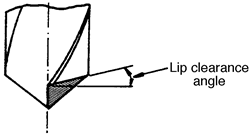
Figure 17: Lip clearance angle of a twist drill
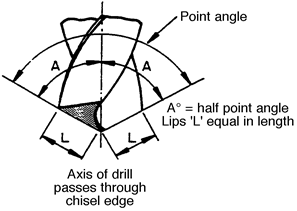
Figure 18: Point angle of a twist drill
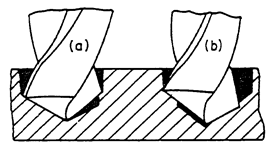
Figure 19: Drill faults
The web thickens towards the shank and after the drill has been re-ground several times the web gradually increases, it is then advisable to re-point the drill a short distance each side to its original thickness using a round faced emery wheel so as to reduce the drilling thrust needed.
|
Student exercise 3 |
1 What precautions are taken when fitting a grinding wheel to a grinder?
2 Preferably, the flanges used to mount a grinding wheel should be _________________ the diameter of the grinding wheel.
3 After mounting a grinding wheel it should be checked that it is running and it is not out of _____________ ________________.
4 The space between the grinding wheel and the tool rest should be __________________________.
5 When would you need to dress a grinding wheel?
6 Never ________________ the work when using a portable grinder.
7 When grinding sheet metal on a pedestal grinder it should be tilted _____________ slightly on the near edge of the tool rest.
8 Grinding wheels should not be allowed to stand partly immersed in a liquid because it could make the wheel out of _______________________.
9 After sharpening a tool on a grinder its cutting efficiency can be improved by hand _______________.
10 When sharpening a knife on a pedestal grinding wheel, the knife should be held so that the blade does not _____________ between the wheel and the rest.
11 It is essential that a knife being sharpened on a grinder should be ________________ in a liquid to prevent the temper of the metal from becoming soft.
12 When sharpening a twist drill what parts of the drill are to be considered?
Check your answers with those given at the end of this section.
– speed variation (mechanical or electronic)
– different capacity chucks (6 mm to 12 mm)
– may be of the Hammer type (suitable for drilling masonry)
– may be used as a powered screwdriver.
– wheels cut and shaped from natural stones such as sandstone, and called grindstones.
– artificial grinding wheels usually referred to as grinding or abrasive wheels.
|
Check your progress |
In questions 1–3 only one of the suggested answers is correct. Place the letter corresponding to your answer in the brackets provided.
1 When using a fixed grinder the distance between the edge of the work rest and the cutting edge of the wheel is:
(a) 0.02 mm.
(b) 0.2 mm.
(c) 2 mm.
(d) 20 mm. ( )
2 You need to check before drilling a hole in a wall that:
(a) you are using the correct size drill.
(b) place a protective sheet on the floor for debris.
(c) correctly mark the location of the hole.
(d) check for electrical wiring behind the wall. ( )
3 List two causes for a grinding wheel to fracture.
4 How is a groove in the cutting edge of a grinding wheel removed?
5 When drilling near live wires what type of electric drill would you use?
6 When using electric portable equipment in a damp situation, electrical protection must be provided by using ________________________________________.
Answers are at the end of the section.
1
(a) place (b) hands (c) clean (d) dangerous (e) onlookers (f) store |
(g) force |
2 using the correct drill bit and keeping it sharp
3 double insulated (unearthed) or cordless drill
4 impact or hammer drill
5 cutting disc and sanding disc
6 exposed wires, correctly connected conductors and damaged insulation or sheath
7 core balance earth leakage breaker or protection system.
1 hand and machine
2 Lift the machine with the left hand at the spindle casing and the right hand on the trigger guard and only press the trigger when near work to be ground.
3 safety guard
4 natural material called grindstones and artificial material called abrasive or grinding wheels
5 abrasive grain or grit, and bond
6 emery and corundum
7 aluminium oxide and silicon carbide or carborundum
8 silicon carbide
9 aluminium oxide
1 easy fit on the spindle; wheel tapped gently with a metal rod
2 half
3 true... balance
4 2 mm
5 when the wheel grinding face is out of shape (grooves etc)
6 bounce
7 upwards
8 balance
9 honing
10 jam
11 cooled
12 lip relief (clearance) angle; front point; lips of equal length; web thinning
1 (c) 2 mm
2 (d) check for electrical wiring behind the wall
3
4 dressing the wheel
5 double insulated or cordless
6 a residual current device (RCD)
Source: http://lrr.cli.det.nsw.edu.au/LRRDownloads/5114/1/5114_1.doc
Web site to visit: http://lrr.cli.det.nsw.edu.au
Author of the text: indicated on the source document of the above text
If you are the author of the text above and you not agree to share your knowledge for teaching, research, scholarship (for fair use as indicated in the United States copyrigh low) please send us an e-mail and we will remove your text quickly. Fair use is a limitation and exception to the exclusive right granted by copyright law to the author of a creative work. In United States copyright law, fair use is a doctrine that permits limited use of copyrighted material without acquiring permission from the rights holders. Examples of fair use include commentary, search engines, criticism, news reporting, research, teaching, library archiving and scholarship. It provides for the legal, unlicensed citation or incorporation of copyrighted material in another author's work under a four-factor balancing test. (source: http://en.wikipedia.org/wiki/Fair_use)
The information of medicine and health contained in the site are of a general nature and purpose which is purely informative and for this reason may not replace in any case, the council of a doctor or a qualified entity legally to the profession.
The texts are the property of their respective authors and we thank them for giving us the opportunity to share for free to students, teachers and users of the Web their texts will used only for illustrative educational and scientific purposes only.
All the information in our site are given for nonprofit educational purposes